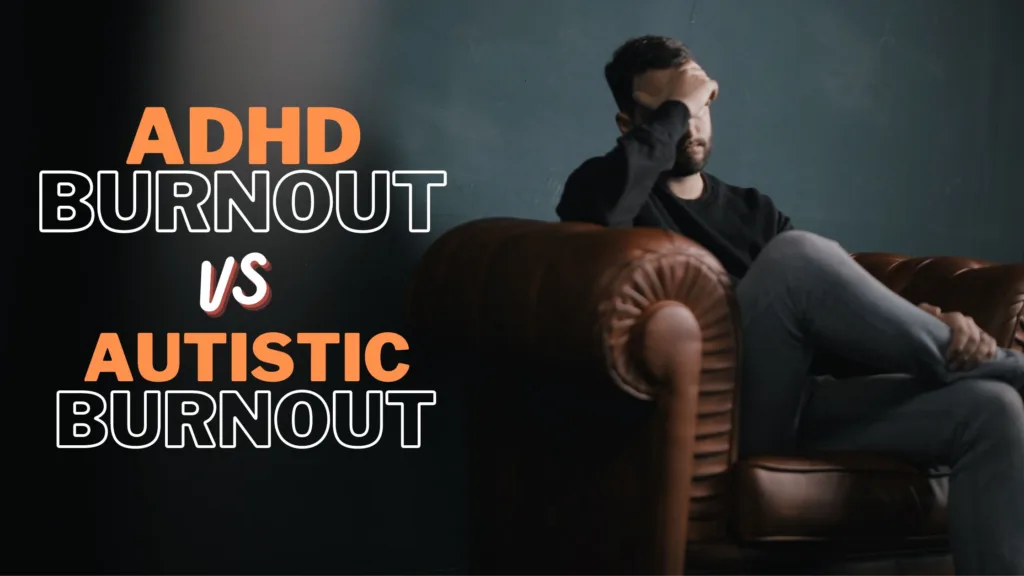Life can feel like a wild ride full of ups and downs for everyone, but it can be even more challenging for folks dealing with ADHD (Attention Deficit Hyperactivity Disorder) and Autism Spectrum Disorder (ASD). These conditions can throw unexpected twists into life’s journey. Today, we’re going to talk about one of the toughest challenges adults with ADHD and ASD face – something called “burnout.” We’ll explore what ADHD burnout and Autistic burnout are, their symptoms, and how they happen in cycles.

First off, Let’s simplify the differences between ADHD and ADHD burnout:
ADHD (Attention Deficit Hyperactivity Disorder):
- It’s a lifelong condition that affects how your brain works.
- You always have some level of trouble with things like paying attention, being impulsive, and being hyperactive.
- These challenges are there every day, and they can make life in school, work, and relationships a bit tricky.
- People use things like medicine, talking to a therapist, and making changes to their daily routines to help with ADHD.

ADHD Burnout
- It’s like a temporary episode that happens to people with ADHD when life gets super tough.
- During burnout, all the regular ADHD difficulties, like not being able to focus or being impulsive, get worse and cause more stress.
- The main sign is feeling super tired, both in your body and mind, which can make it hard to do things.
- Burnout happens in cycles, meaning it comes and goes. It usually starts with pushing yourself too hard, then feeling exhausted, taking a break, and slowly feeling better.
- It often happens when you try to do too much and don’t give yourself enough rest.
- So, in simple terms, ADHD is a long-lasting condition that affects your daily life, while ADHD burnout is a temporary phase where your ADHD symptoms get really tough because you pushed yourself too hard. Knowing the difference helps people with ADHD take care of themselves better and avoid burnout.

ADHD Burnout Cycle in Adults
Understanding how ADHD burnout works in cycles is important. It usually goes like this:
- Starting: People with ADHD often use different strategies to handle their symptoms, like medication, therapy, or tools to stay organized.
- Pushing Too Hard: The desire to prove themselves or meet society’s expectations can lead to working too much and too long.
- Diminishing Returns: Even if things start well, it becomes harder to keep up the effort. People start feeling more tired and stressed.
- Burnout: Eventually, burnout happens. This is when all those symptoms we talked about earlier hit hard, and everything feels overwhelming.
- Taking a Step Back: In response to burnout, people might need to take a break from social activities or work to recover.
- Getting Back Up: After some rest and self-care, they can start feeling better and return to their initial coping strategies.

Now Let’s break down the key differences between Autism and Autism burnout
Autism
- Autism is a lifelong condition that affects how a person’s brain works.
- It can make people see and interact with the world in a unique way. They might have different types of strengths and challenges.
- These differences are always there, from childhood into adulthood.
- Autism can affect things like socializing, communicating, and dealing with sensory experiences (like bright lights or loud sounds).
Autism Burnout
- Autism burnout is like a temporary state of feeling really, really exhausted and overwhelmed because of the challenges of living with autism.
- During burnout, the usual difficulties that come with autism, like trouble with communication or sensory sensitivities, become more intense and stressful.
- The main sign of burnout is extreme tiredness, both physically and mentally, which can make it hard to do even simple things.
- Burnout happens in cycles, meaning it comes and goes. It often starts with pushing yourself too hard, then feeling drained, taking a break, and slowly getting better.
- It often occurs when someone tries hard to fit into a world that doesn’t always understand them and doesn’t give them enough support.

So, in a nutshell, autism is a lifelong way of experiencing the world, while autism burnout is a temporary phase when the challenges of autism become very overwhelming, and everything feels exhausting. Recognizing this difference can help people with autism take care of themselves better and prevent burnout.
Autistic Burnout Cycle in Adults
Just like with ADHD burnout, autistic burnout follows a pattern:
- Constantly Adapting: Adults with ASD often use a lot of energy trying to fit into a world that doesn’t always understand them. This can mean masking their true selves.
- Pushing Too Hard: All that effort to fit in and be “normal” can lead to overexertion, which causes stress and exhaustion.
- Burnout: Eventually, the strain becomes too much, and that’s when autistic burnout happens. It’s when all those symptoms we just talked about hit you hard.
- Stepping Back: As a way to cope, people might need to take a break from social stuff and reduce sensory input.
- Getting Better: Recovery involves taking care of oneself and slowly starting to adapt again.
ADHD and autistic burnout are real challenges that adults with these conditions face. Recognizing the signs and understanding that these burnouts happen in cycles is crucial. If you or someone you know is dealing with ADHD or autistic burnout, it’s important to seek professional help, practice self-care, and build a support network.
Remember, you’re not alone in this journey, and there are resources and strategies to help you navigate life with ADHD or ASD. More Detailed Article on ADHD vs ASD.

Pingback: ADHD vs ASD – Understanding the Difference – Search Candid
Pingback: Apple iPhone 15 Pro Max: A Prodigy in Your Pocket – Search Candid
Pingback: God Complex – Traits, Causes, and Effects
Pingback: 5 Top Resources For Helping ADHD Kids Thrive - Elle Blonde | Luxury Lifestyle Destination | Travel, Food & Drink, Interiors & More